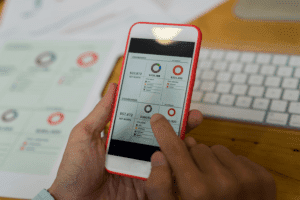
At the end of your accounting periods, inventory valuation allows you to establish the cost of making the goods you sell versus how much profit you’re making. A real-time inventory tracking system can minimize the manual accounting tasks common in properly valuing inventory. Implementing real-time inventory tracking can also payroll improve planning, pricing, shipping, and the overall customer experience. Deploying a modern manufacturing planning engine can also ensure sufficient inventory is available to meet the demands of the business but that excess inventory is not causing undue strain on the business. Rootstock has purpose-built features for real-time inventory management for manufacturers. Manufacturing cost accounting systems then must capture the cost of manufacturing but be flexible enough for many different manufacturing methods, processes, and technique.

Direct labor costs

In a manufacturing business, there are some important terms you need to understand when it comes to calculating the costs of manufacturing your product, as well as the amount of inventory you hold. A manufacturing business operates with complexities in the world of making things, from toys to tools. The manufacturing process needs careful accounting to keep everything running smoothly. The software should have the ability to generate financial reports and provide insightful analysis of production performance. CPA Practice Advisor recommends “mapping out” processes as a first step to identifying business inefficiencies. Once a process is defined, a close review of the resources required at each step can reveal bottlenecks and risks.
Manufacturing Costs Explained
- By tracking every step in the production process, you’ll be able to quickly identify any problems or areas where improvements could be made.
- This blog post will explore a range of indispensable tips and proven strategies specifically tailored to the unique challenges of accounting in manufacturing.
- These indirect costs, such as electricity, maintenance, and rent, might not be directly tied to producing a product but are essential for manufacturing operations.
- For industries where speed is critical, such as aerospace or automotive, faster processes like repetitive manufacturing or assembly are often preferred.
- Each process, whether traditional methods such as casting, welding, and machining or contemporary approaches such as additive manufacturing, presents unique advantages tailored to the specific requirements of production.
- If you are yet to implement a manufacturing ERP system, consider picking one with built-in financial reporting capabilities.
- Implementing robust accounting practices can improve the business performance of manufacturing companies.
The core concepts of the manufacturing business involve dealing with the cost of goods sold and inventory valuation. A lot of finished products are produced from the raw materials in the manufacturing company. Managing the risk and cash flow is very important for the efficient accounting of a manufacturing company.
Subscribe to Taxfyle
- Firstly, accurate and up-to-date inventory data allows manufacturing organizations to avoid stockouts and overstocking situations.
- High-volume methods like continuous manufacturing are often the most cost-effective, while processes such as job shop manufacturing may be more expensive due to the custom nature of production.
- Continuing the toothpick example, the cost of the wood, labor, equipment cleaning supplies, security guard, and electricity all add up to the total product cost used for manufacturing accounting.
- Manufacturing accountants also keep an eye on other important areas of expenditure to ensure the budget is followed throughout the financial year.
- In this article, we’ll explore the advantages of flowcharts and the steps for creating them.
- Cost accounting processes might miss the different units of measure, resulting in inaccurate reports, cost analyses, and forecasts.
Production costing methods are manufacturing accounting methods used to calculate and analyse your costs to produce finished goods. In production management, manufacturing cost accounting seeks to determine the cost of goods sold to better understand revenue and profitability at both the business level and the individual product level. This knowledge enables you to plan better budgets and spot production inefficiencies.
How to Create an Accounting Process Flowchart
Our experts have successfully streamlined accounting aspects for manufacturing companies. Producing credible financial track records helps businesses reinforce investor faith and build a reputation for honesty. Auditing allows a manufacturing business to ensure that the accounting processes and standards deployed in analyzing Insurance Accounting a company’s finances are up to the mark. This helps entrepreneurs rest assured that their firm’s statements and records, and in turn the company’s adherence to business ethics and integrity. Accurate financial records are important for both capital expansion goals and to avoid legal repercussions arising from monetary misappropriation.

Once a product has been manufactured, its costs will typically be transferred from the manufacturing account to the income statement along with the price markup. Also known as the lower of cost or market rule, impairment testing involves ascertaining whether the amount at which inventory items are recorded is higher than their current market values. This task may be completed at relatively long intervals, such as at the end of each annual reporting period.

This method considers numerous future costs that might impact the final cost of producing the product. The process essentially involves estimating these costs and ensuring that the company remains profitable. This method allows businesses to undertake a proactive approach so that they manufacturing accounting process make a decent margin even if the market witnesses volatility. Target costing also allows businesses to foresee products that might not quite make the cut and discontinue them to capitalize on those that perform better. Despite its advantages, target costing requires constant monitoring of market trends and other parameters to remain rooted.
- These documents are important when the manufacturing business needs to showcase its credibility and financial performance to investors or funding partners when raising capital.
- Direct labor costs include wages, benefits, and insurance for workers directly involved in production.
- Get $30 off a tax consultation with a licensed CPA or EA, and we’ll be sure to provide you with a robust, bespoke answer to whatever tax problems you may have.
- Her articles, whitepapers, and blog posts are known for their clarity, practicality, and actionable insights.
- The total manufacturing cost also informs two crucial KPIs for determining a company’s Gross Profit and Gross Margin – Cost of Goods Manufactured (COGM) and Cost of Goods Sold (COGS).
- This method is ideal for creating high-precision parts with tight tolerances, and it is often used in the production of mechanical components.
Additionally, these standards can be used by investors to get a better understanding of an organization’s financial position before making investment decisions. In manufacturing, these costs rise with increased production and fall with decreased production, such as the cost of wood, production labor, and packaging for toothpick production. There is much to learn and many decisions to make along the way, but it is a critical task for manufacturers. You can automate your inventory management by implementing inventory management software, barcode scanners, and warehouse robotics.
- Furthermore, efficient inventory management facilitates accurate cost calculations and financial reporting.
- Different costing methods can significantly impact business operations and financial interpretations.
- Job order costing for manufacturing is desirable for manufacturers who produce customized or variable goods.
- Job costing is advantageous for returning close-to-exact cost values per finished project or finished good.
- Optimizing workflows is one step to achieving successful accounting firm performance.
Overhead Cost Assignment
Documenting compliance and risk mitigation processes with flowcharts ensures transparency and encourages consistency. It also allows for periodic review of compliance and risk measures relative to current regulations and evolving threats. If a compliance or risk mitigation failure occurs, the flowchart helps you identify where and how the process can be improved.
